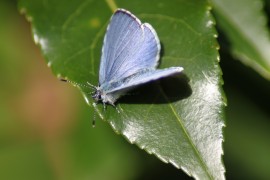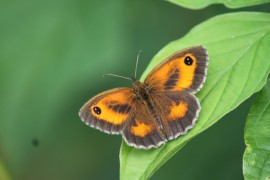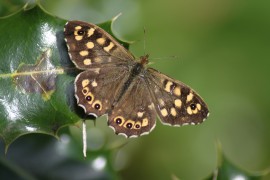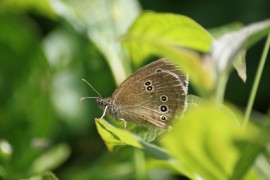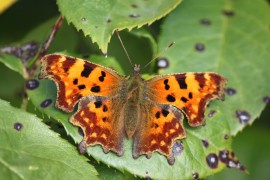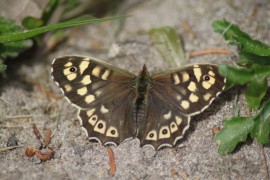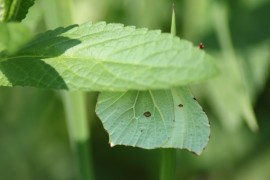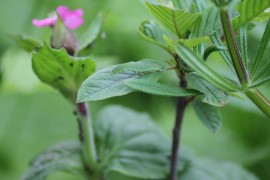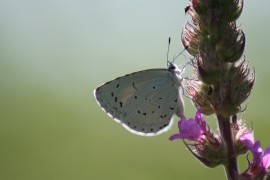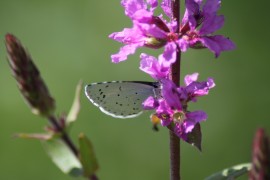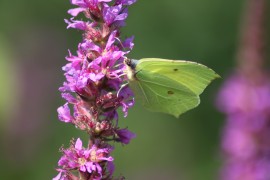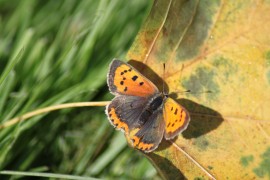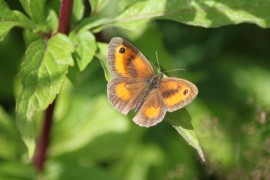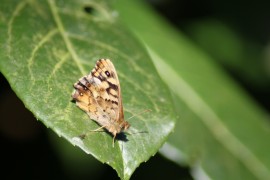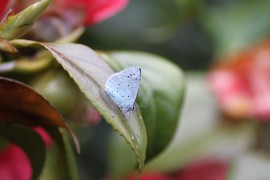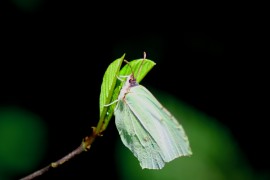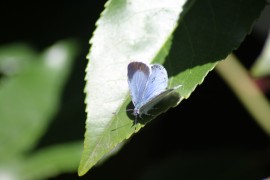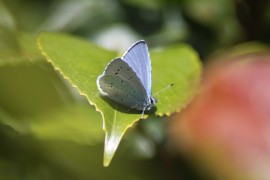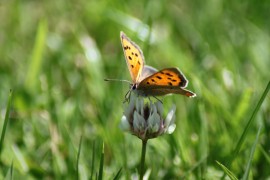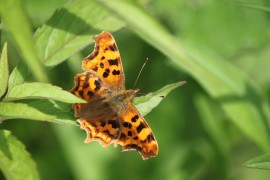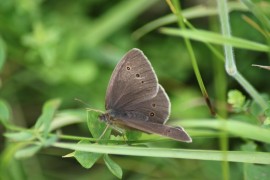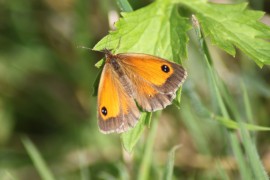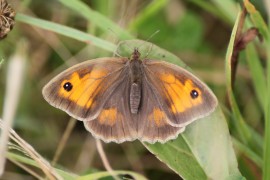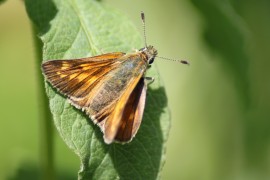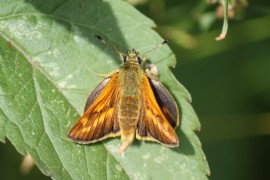Wildlife gardening - the 'background foliage'
By Martin Kalaher
The wildflower meadow and herbaceous borders undoubtedly attract a wide range of butterflies, bees and many other interesting insects. These are the 'hot-spots' in the garden where much of the insect activity is concentrated but what about the supporting role of the rest of the 'greenery', the trees, shrubs and hedgerows? In this third article, I will take a look at the rest of the 'background foliage', reflecting on what choices may enhance the value of the garden from a wildlife perspective? I will share with you what I think works well, and just as importantly what doesn't. As you are reading this article on the Sussex BC website the emphasis will be on Lepidoptera but in passing I will mention some of the other local wildlife that are either resident or regular visitors to the garden.
Hedgerows
I will start with hedgerows for that's where my interest in wildlife gardening began, not that I realised it at the time! I have always preferred deciduous hedges, especially Beech, but as the years have drifted by my preference has firmly leaned towards the informality of the mixed deciduous hedge. In Sussex, we are so used to our countryside hedgerows that I suspect that many of us tend to take them for granted. It was only in 2016 that it fully dawned on me just how many insects inhabit the sun-exposed parts of hedges. Observing the top of the garden hedge, with the sun low in the sky, I was astonished at the numbers of insects in front of me. I remember thinking at the time that there were probably more insects per square metre on this sun-bathed hedgerow than any other part of the garden, and that includes the wildflower meadow. I accept that many were little things (that I cannot name) but it was quite a spectacle. It should be no surprise that it is the top of the hedgerow where I can always find a few wasps foraging through the foliage, 'hoovering' up these tiny insects to feed their grubs. As an aside, the Common Wasp really does get a 'bad press', which for the most part is surely unjustified. I have one or two nests in the garden every year, spend a lot of time in the garden but have yet to be stung. The workers are foraging for insects, not looking to make war on us human beings. They are also very good at keeping midge numbers reduced and this is a blessing for those of us who enjoy a stroll around the garden of a summer's evening.
In total, we have approximately 75 metres of mixed deciduous hedgerow which contain the following species: Alder, Beech, Blackthorn, Bramble, Common Oak, Dogwood, Dog Rose, Field Maple, Field Rose, Guelder Rose, Hazel, Hawthorn, Holly, Hornbeam, Mountain Ash, Privet, Silver Birch and Yew. When we planted the hedges 20+ years ago, there was no plan, as such, just the idea that an extensive variety would be interesting. Now the hedges have matured I am very pleased to have gone for lots of variety. In high summer the hedges are teeming with insect life and whilst I do not pretend to know what every insect likes to eat, I reckon that by providing plenty of choice something is bound to take their fancy! The hedgerow to the east of our property has been left to grow tall and wild as this suits species such as Holly, Yew, Field Maple, Hazel and Alder. The hedgerow to the south of the garden is adjacent to the wildflower meadow and this I keep short, to avoid excessive shading of the meadow. It is here that large numbers of Gatekeepers (40 in a good year), a few Large Skippers and the occasional Ringlet can be found.
As a garden hedgerow plant, I don't especially like the long sharp thorns of Blackthorn (very tough on the unsuspecting small child and even tougher on thin plastic footballs!) but I tolerate it as Brown Hairstreaks may be encouraged into the garden to lay their eggs. I recorded 41 eggs in the garden in the autumn/early winter 2016 with most of the eggs laid on the outside of the east-facing hedge and not in the garden itself. This length of hedgerow has a fair amount of sun-exposure and is very sheltered, courtesy of the height and width of the hedge. As well as its long sharp thorns, Blackthorn does have another serious downside as it sends out long, horizontal, underground roots which emerge as suckers, and these can be a bit of a nuisance and difficult to control.
Dogwood is another hedgerow plant about which I am slightly ambivalent. It tolerates being cut back hard (which is very helpful if one wishes to maintain a hedge at a particular height) and it does produce lots of fresh green leaves for hungry insects, but it too sends out suckers and it can be very invasive.
As a complete contrast to the mixed deciduous hedges I also have two Privet hedges (which I inherited) and they are more-or-less sterile green structures with few insects paying them any attention, other than for somewhere to perch.
Garden Pond
Every wildlife garden should have a pond as it provides chemical-free water for all wildlife to drink and bathe. Our pond, which we have had since 2004, plays host to badgers, foxes, many species of birds and of course some insects. Wasps and to a lesser extent bees always seem to have a thirst but not that many butterflies appear to visit the pond, presumably keeping well hydrated through nectar and honeydew. In the early years, we had many species of dragonflies and damselflies but as the pond has become rather overgrown with rushes and pond grasses the variety and numbers have reduced. Although frogs occasionally visit the pond they have never bred, which is rather surprising. There can be up to 50 Common Newts in the spring and for several years we had a few Great Crested Newts but I've not seen any for the past three years.
That others might benefit from my experience I will mention two things that didn't turn out quite how I would have liked. At the planning stage I decided on a butyl liner but I was concerned that it might be vulnerable to punctures, from underneath by flints, and from above by Herons. In recent years we have had very regular visits from Badgers and in 2016 they would be my biggest concern, as they will dig up anything in search of a juicy worm. In 2004, with concerns about flints and Herons we put a layer of protective matting both under the butyl liner and also above. There were no obvious problems with this strategy for a few years but as the rushes and pond grass became well-established it was apparent that their roots were so enmeshed in the protective matting it was no longer possible to do any effective weeding. The outcome is a pond that is gradually becoming choked with vegetation. Most autumns, when the water level is very low, I cut everything back to ground level and that works for a while.
If I had my time again I would still use two lots of protective matting but not put in any pond grasses. I didn't plant the rushes; they were presumably introduced by webbed feet! If a garden has a wildlife pond the local ducks are bound to investigate and bring different plants with them. I don't fret when things don't quite work out the way as intended. Some things can be rectified, some cannot. If the pond eventually turns into a bog garden, then so be it. I already have Purple Loosestrife on the fringes of the pond and if they were to colonise a developing bog garden, then that wouldn't be such a bad outcome.
In 2004 I stocked the pond with a nice variety of plants but many have disappeared over the years as a few dominant species have taken over. There is a still a reasonable variety with plants such as Marsh Marigolds, Irises, Creeping Jenny and many others. I have plenty of Purple Loosestrife which has a handsome flower head and its nectar is clearly attractive to many of the garden butterflies. Although this plant species is much reviled in North America (and indeed banned by law) I'm not aware of it being a problem in this country.
Trees and shrubs
If space permits I would always plant Common Oak, for it is clearly our most important tree species with several hundred different insect species happy to nibble away at its leaves. Silver Birch also supports scores of insect species and can be accommodated in smaller gardens. We have three Cherry trees, which produce huge amounts of nectar in the spring and at times can be covered in a couple hundred or so Honey bees and a good variety of Bumble bees.
We have five remaining Scots Pine, which will probably survive the axe. I have mixed feelings about this species as the needles acidify the soil and little grows with any enthusiasm up to 10 metres from the trunk. However, four species of Tits, together with Goldcrests regularly feed in the canopy and without the Pines the garden would be a poorer place.
On the west side of the property there are both Portuguese and Common Laurel. Both do a good job in providing a screen but they also produce an abundance of nectar (mostly for bees) and the Portuguese Laurel also provides an alternative to Ivy for the eggs of Holly Blue. Personally, I favour Portuguese Laurel as I think it is a more attractive shrub and it also gets my vote as I now associate it with egg-laying Holly Blue. Another discovery in 2016 involved badgers and their 'poo'. I hadn't realised just how much our local Badgers enjoy harvesting the fruit of Common Laurel. They will also eat the fruit of Portuguese Laurel but as the fruit of the latter is much smaller I guess it is more energy-efficient for the badgers to eat the larger fruit of Common Laurel. Even then most of it seems to pass through undigested, which is evident when one examines the 'poo'. I suspect these garden badgers must be very hungry to spend so much effort for what appears to be so little reward. The badgers probably forage in the garden all-year-round but their presence is most obvious in late summer. This is when the ground tends to be 'bone-hard' and doubtless their favourite food, the earthworm, is largely out of reach.
As I am not a 'conventional' gardener I have very little knowledge of garden shrubs but I will mention a native shrub which is worth planting in any sunny, well-sheltered garden, and that is Alder Buckthorn. My garden is very open and is blessed with a lot of sunshine but it is far from sheltered as the winds are channelled between the scarp slope of the South Downs and the southern outskirts of the village of Storrington. Our house was built on the foundations of the Black Windmill, the last remaining mill in Storrington, and it is a windy spot. However, there are one or two sheltered areas in the garden and that is where I planted some Alder Buckthorn saplings 5-6 years ago. In 2016 three modest-size bushes played host to more than 50 mature Brimstone caterpillars and without lasting damage to the shrubs.
Earth Bank
As mentioned in a previous article, when the wildflower meadow was created all the turf was transferred to the western border of the garden, thus forming an earth bank. It is difficult for an earth bank to look especially attractive but it does create an interesting habitat. Our earth bank was quickly colonised by Short-tailed Field Voles, Wood Mice, Bank Voles and Slow Worms, with the occasional Grass Snake putting in an appearance. It also provides a ready home for Common Carder Bees and Common Wasps. Inevitably nettles will appear but as many of our native butterflies lay their eggs on Common Nettle one can make out a good case for coping with one or two patches in the garden.
The Lawn
Some gardeners will spend a lot of time and energy creating an immaculate uniform grass lawn but I suspect the majority do not, just keeping the grass cut short so that it looks neat and tidy. If the clippings are removed and lawns not treated with chemicals they can hold a remarkable variety of wild flowers, all desperate to show themselves but rarely given the chance. It is easy enough to stop mowing a section of lawn sometime in June or July and see what happens. In many cases, what happens is that lots of flowers appear and our native insects just love it. As gardeners, we tend not to do this as it looks untidy! I understand this sentiment as I do the same! My wildflower meadow and herbaceous borders can sometimes look a bit scruffy, especially if there has been heavy rain or high winds and so I keep the grass 'neat and tidy' partly so that others do not think I am a lazy gardener and partly because I think it looks better that way.
Brief summary
I have never designed a wildlife garden from scratch. My garden has just evolved in a piece-meal way with no particular goal in mind. It is only in the past 6-7 years that I decided that it would be an insect-orientated garden and specifically a butterfly-friendly garden. I have been well-rewarded for my efforts.
Most of us probably don't give enough thought to the 'green infrastructure' that makes up most of the garden but with a bit of fore-thought it is perfectly possible to create an interesting garden but with a wildlife slant. To 'bang the drum' yet again, it is always worthwhile and generally very rewarding if one plants 'British Natives' whenever possible.
In the fourth and final article, I will explore in more detail how we might encourage butterflies into the garden to breed. What butterfly larvae food plants can we provide so that not only do we have butterflies visit the garden to nectar but also persuade them to stay for a while and lay their eggs?
Martin Kalaher
January 2017
Read part one: Wildlife Gardening - the Herbaceous border.
Read part two: Wildlife Gardening - the Wildflower meadow.
Read part four: Wildlife gardening - Breeding butterflies and other wildlife
If you have any questions you would like to ask Martin please email web@sussex-butterflies.org.uk.



